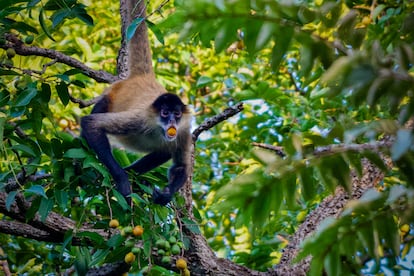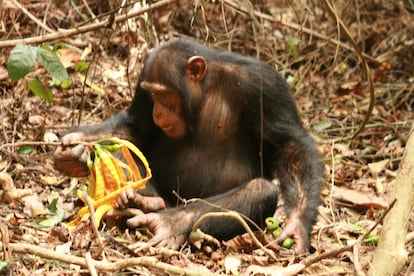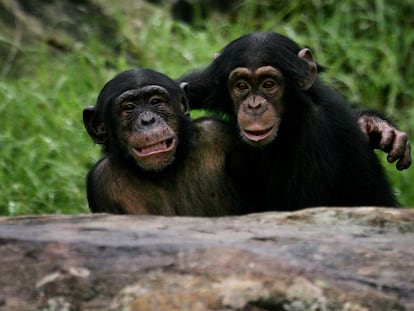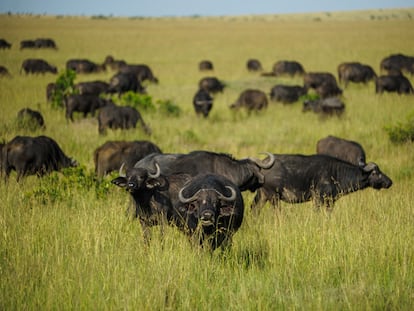Drunk butterflies and inebriated elephants: Animals also consume alcohol
From non-human primates to beetles, dozens of species intentionally ingest ethanol, and even have special enzymes to metabolize it

The Bicyclus anynana butterfly, native to East Africa, derives part of its diet from fermented nectar of a palm known for producing high levels of alcohol. Across the globe in North America, American waxwings have been observed flying erratically and colliding with objects. Necropsies of some of these birds revealed atrophied livers, likely from consuming overripe, fermented berries. In laboratory studies, male and female flies from various Drosophila species have shown shifts toward more solitary or promiscuous behavior when exposed to ethanol.
A review of current scientific knowledge highlights that alcohol consumption in the animal kingdom is more common than previously believed. Dozens of species, including mammals, birds, and insects, show a preference for fruit or nectar containing some level of alcohol. The reasons for ingesting this potentially toxic and dangerous substance range from seeking a source of calories to exhibiting disinhibited behavior, similar to that seen in humans.
Until the beginning of this century, even the scientific community believed that the consumption of a substance as objectively harmful as alcohol was a uniquely human phenomenon. This was considered a universal behavior; archaeological sites from diverse cultures have revealed evidence of beer, wine, or other drinks made by fermenting the sugar in fruit to produce ethanol.
However, the drunken monkey hypothesis emerged, suggesting that other primate species also consume alcohol. A decade ago, this behavior was linked to the ancestors of orangutans, chimpanzees, and humans descending from the trees around 10 million years ago. Notably, the only great primate that has not been observed indulging in fermented fruits is the orangutan, the one species that remains largely in the treetops. The rationale is that the ground hosts the ripest fruits, colonized by yeasts like Saccharomyces cerevisiae, the true agents of sugar-to-alcohol conversion.
This hypothesis, however, does not account for many other animals. In a paper published in Trends in Ecology & Evolution, the authors compile numerous cases of various species observed consuming fermented fruit. Although the researchers note that many of these observations lack certain criteria for full scientific validation — such as confirming the presence of ethanol, measuring its content in the fruit, or detecting metabolites indicating intoxication — they argue that there is enough evidence to support the widespread nature of this behavior.
Among mammals, at least 85 species have genetic adaptations for alcohol metabolism. These adaptations include variations in the genes encoding enzymes like aldehyde dehydrogenase (ALDH), which plays a role in metabolizing certain alcohols. Such genetic modifications are found not only in primates but also in other frugivorous animals, such as the large flying fox, one of the largest bat species. Ethanol metabolites have even been detected in the fur of some shrews and the tricolored squirrel.

“We’re moving away from this anthropocentric view that ethanol is just something that humans use,” senior author Kimberley Hockings of the University of Exeter said in a news release. “It’s much more abundant in the natural world than we previously thought, and most animals that eat sugary fruits are going to be exposed to some level of ethanol.”
With more than 325,000 species of flowering plants (angiosperms), many fruits provide the raw material — sugars — for the production of natural alcohols. Although the oldest flowering plant in the fossil record dates back only 130 million years, molecular clocks suggest their origin dates back even further. During their evolution, angiosperms developed protective mechanisms, including compounds like geraniol, methanol, ethanol, and isopropanol, which possess fungicidal properties. It is estimated that the first yeasts emerged around 200 million years ago. Biologist Laura Camón wrote in an article that “yeasts have developed a strategy to eliminate their competition: through fermentation, they convert sugar into ethanol, which is harmful to bacteria.”
In all ecosystems — from the cold forests of Finland to the jungles of Uganda — fruits, nectars, and sap with alcoholic content can be found. In most cases, their alcohol content does not exceed 1%, similar to non-alcoholic beer. However, this research highlights dozens of plant species that surpass this concentration. An exceptional case is the macora (Astrocaryum standleyanum), a palm native to Costa Rica, Panama, and extensive areas of Ecuador and Colombia, whose ripe fruit can reach alcohol levels up to 10.3%, comparable to white wine. Of the 61 plant species included in the study, only 10 exceed the 1% threshold. But the researchers point out that the impact on the body varies, and the effects of prolonged consumption must also be considered.
Although not all animals have the ALDH enzyme, many have a different enzyme specific to ethanol metabolism: alcohol dehydrogenase (ADH). The extent of ethanol consumption varies widely. Beyond primates, both human and non-human, one of the most notable examples is the fruit fly, also known as the vinegar fly. Female flies lay their eggs in fermented fruit with alcohol levels reaching up to 15%, comparable to red wine. Widely used as a model organism in laboratories, Drosophila melanogaster is well-studied; for instance, it is known to use ADH to convert alcohol into lipid deposits. However, systematic studies on ethanol consumption are rare. One study found that worker honey bees collecting nectar possess this enzyme, while those caring for larvae and remaining in the hive do not. Both enzymes are present in the tongues, esophagi, and stomachs of primates and other mammals, including several species of fruit bats.
In a series of experiments, it was shown that when given the choice, several species of bats, slow lorises (a type of primate), and Campbell’s dwarf hamsters prefer fruit with a higher ethanol content. Metabolites found in the hair of tree shrews confirm their assimilation of relatively large quantities of alcohol. Even cases of drunk elephants have been observed. What motivates animals to consume a substance that can be harmful, pose a danger, or reduce their ability to handle predators? The study’s authors acknowledge that they are not entirely sure but dismiss the idea of accidental ingestion as the primary cause. Instead, the widespread presence of yeast and ethanol, coupled with genetic adaptations for metabolization, suggests more deliberate consumption.
Indeed, researchers propose that ethanol consumption could offer several advantages for wild animals. Firstly, it is a source of calories. Additionally, volatiles from fermentation may help guide insects, birds, and mammals to food sources. Ethanol could also have medicinal properties, as seen in fruit flies, which lay their eggs in alcohol-containing substances that protect them from parasites.
“On the cognitive side, ideas have been put forward that ethanol can trigger the endorphin and dopamine system, which leads to feelings of relaxation that could have benefits in terms of sociality,” said Anna Bowland, the first author of the research.
For example, studies show that Drosophila simulans, flies closely related to fruit flies, exhibit more frequent mating after exposure to alcohol. Meanwhile, male D. melanogaster are known to seek out alcohol after failed mating attempts. However, to confirm the link between ethanol and behavioral changes, Bowland notes that it would be necessary to determine “if ethanol is producing a physiological response in the wild.”
Sign up for our weekly newsletter to get more English-language news coverage from EL PAÍS USA Edition
Tu suscripción se está usando en otro dispositivo
¿Quieres añadir otro usuario a tu suscripción?
Si continúas leyendo en este dispositivo, no se podrá leer en el otro.
FlechaTu suscripción se está usando en otro dispositivo y solo puedes acceder a EL PAÍS desde un dispositivo a la vez.
Si quieres compartir tu cuenta, cambia tu suscripción a la modalidad Premium, así podrás añadir otro usuario. Cada uno accederá con su propia cuenta de email, lo que os permitirá personalizar vuestra experiencia en EL PAÍS.
¿Tienes una suscripción de empresa? Accede aquí para contratar más cuentas.
En el caso de no saber quién está usando tu cuenta, te recomendamos cambiar tu contraseña aquí.
Si decides continuar compartiendo tu cuenta, este mensaje se mostrará en tu dispositivo y en el de la otra persona que está usando tu cuenta de forma indefinida, afectando a tu experiencia de lectura. Puedes consultar aquí los términos y condiciones de la suscripción digital.
More information
Últimas noticias
Most viewed
- Reinhard Genzel, Nobel laureate in physics: ‘One-minute videos will never give you the truth’
- Oona Chaplin: ‘I told James Cameron that I was living in a treehouse and starting a permaculture project with a friend’
- Pablo Escobar’s hippos: A serious environmental problem, 40 years on
- Why we lost the habit of sleeping in two segments and how that changed our sense of time
- Chevy Chase, the beloved comedian who was a monster off camera: ‘Not everyone hated him, just the people who’ve worked with him’











































